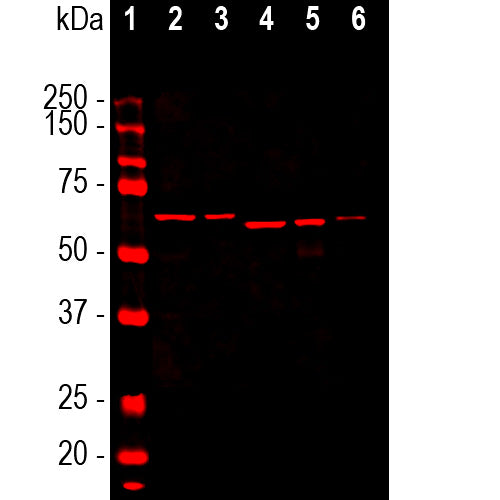
EnCor Biotechnology
Mouse Monoclonal Antibody to α-Internexin/NF66, Cat# MCA-2E3
Description
This antibody was made against full length recombinant rat α-internexin and the antibody binds to the α-internexin protein from different mammals, including human, rat, and mouse. It is clean and specific on western blots, ICC and IHC of rodent and human material. This antibody is used to identify material from individuals suffering from neurofilament inclusion body disease, a form of frontotemporal lobar degeneration (4,5). We also supply an alternate mouse monoclonal antibody, MCA-1D2, a rabbit polyclonal antibody, RPCA-a-Int, and a chicken polyclonal antibody, CPCA-a-Int to this protein.
- Cell Structure Marker
- Cell Type Marker
- Cytoskeletal Marker
- Developmental Marker
- Immunohistochemistry Verified
- Mouse Monoclonal Antibodies
- Pathology Related Marker
Add a short description for this tabbed section
| Immunogen: | Full length recombinant rat alpha-internexin expressed in and purified from E. coli |
| HGNC Name: | INA |
| UniProt: | Q16352 |
| Molecular Weight: | 64-66kDa by SDS-PAGE |
| Host: | Mouse |
| Isotype: | IgG1 |
| Species Cross-Reactivity: | Human, Rat, Mouse, Cow |
| RRID: | AB_2572335 |
| Format: | Protein G affinity purified antibody at 1mg/mL in 50% PBS, 50% glycerol plus 5mM NaN3 |
| Applications: | WB, IF/ICC, IHC |
| Recommended Dilutions: | WB: 1:10,000. IF/ICC Not tested in house. IHC: 1:1,000-5,000. |
| Storage: | Store at 4°C for short term, for longer term store at -20°C. Stable for 12 months from date of receipt. |
α-internexin is a Class IV intermediate filament protein originally discovered by two different groups of researchers as it copurifies with NF-L, NF-M and NF-H, the better known major neurofilament "triplet" subunits (1,2). It is expressed only in neurons and in large amounts early in neuronal development, but is down-regulated in many neurons as development proceeds. Some neurons express α-internexin in the absence of NF-L, NF-M and NF-H, though most mature neurons express all four proteins. This α-internexin antibody has been shown, in peer reviewed publications, to reveal the upregulation of α-internexin in facial neurons following experimental axotomy followed by down regulation on axonal regeneration (3). It is also the standard reagent used to identify and classify patients with neurofilament inclusion body disease, a specific form of frontotemporal lobar dementia (4-6). Finally it has been used to confirm the presence of circulating antibodies to α-internexin in the blood of certain patients with endocrine autoimmunity (7).

Chromogenic immunostaining of a formalin fixed paraffin embedded human cerebellum section with mouse mAb to α-Internexin, MCA-2E3, dilution 1:1,000, detected in DAB (brown) using the the Vector Labs ImmPRESS method and reagents with citrate buffer retrieval. Hematoxylin (blue) was used as the counterstain. The 2E3 α-Internexin antibody strongly labels neuronal processes in both rat and human brain. This antibody performs well in testing with both 4% PFA and standard NBF fixed tissues. Mouse select image for larger view.
1. Pachter J and Liem RKH. Alpha-Internexin, a 66-kD intermediate filament-binding protein from mammalian central nervous tissues. J Cell Biol 101:1316-22 (1985).
2. Chiu FC, et al. Characterization of a novel 66 kd subunit of mammalian neurofilaments. Neuron 2:1435-45 (1989).
3. McGraw T. et al. Axonally transported peripheral signals regulate alpha-internexin expression in regenerating motoneurons. J Neurosci. 22:4955-63 (2002).
4. Evans J. et al. Characterization of mitotic neurons derived from adult rat hypothalamus and brain stem. J. Neurophysiol. 87:1076-85 (2002).
5. Cairns NJ. et al. Alpha-internexin is present in the pathological inclusions of neuronal intermediate filament inclusion disease. Am . J. Pathol. 164:2153-61 (2004).
6. Uchikado H1, Shaw G, Wang DS, Dickson DW.
Screening for neurofilament inclusion disease using alpha-internexin immunohistochemistry. Neurology 64:1658-9 (2005).
7. Rajasalu T, et al. Demonstration of natural autoantibodies against the neurofilament protein alpha-internexin in sera of patients with endocrine autoimmunity and healthy individuals. Immunol. Lett. 94:153-60 (2004).
The antibody has also been sold through many OEM partners, and almost 70 peer-reviewed publications making use of it can be found by searching Google Scholar for "2E3 AND internexin" or, if you are reading this online, simply by selecting this link.
Add a short description for this tabbed section





